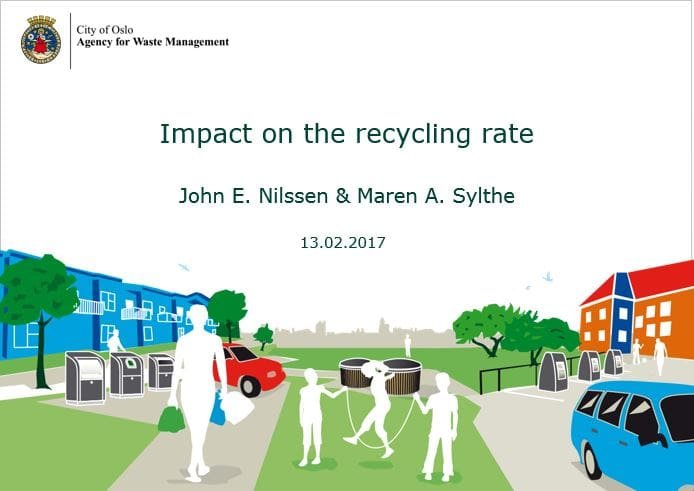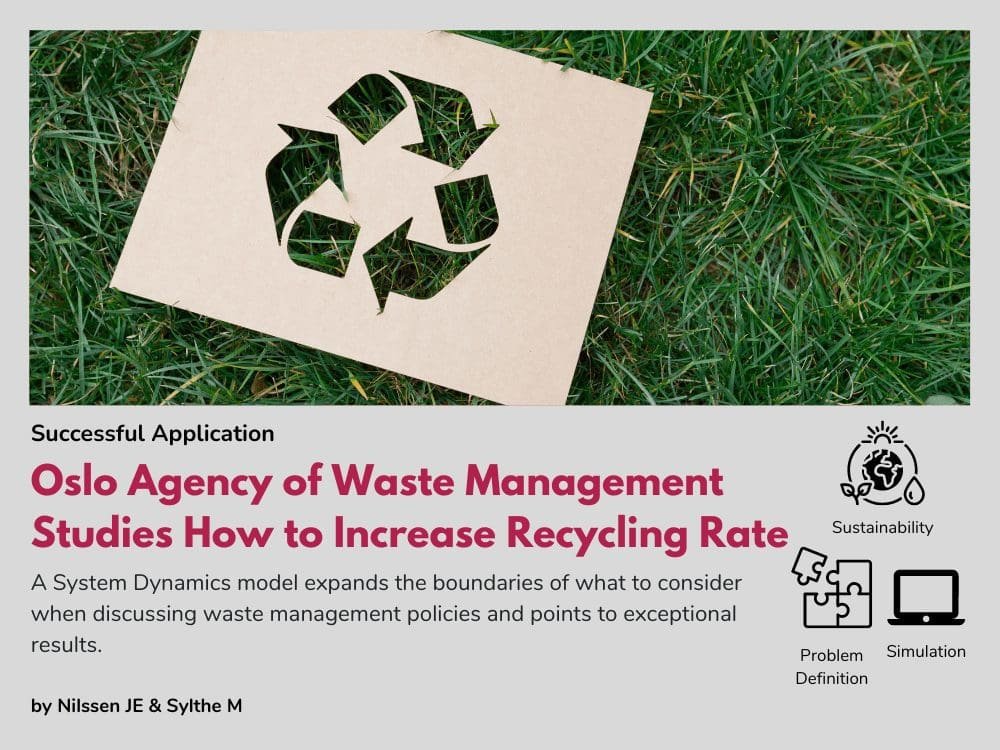Oslo Agency of Waste Management Studies How to Increase Recycling Rate
The Issue You Tackled
One of the goals for the waste policy in the municipality of Oslo is to achieve a recycling rate at least 50 % from the household waste by 2018. In 2015 the recycling rate was 38 %. The result in 2016 was 38 % and this raises the question whether the objective of 50 % is realistic given the portfolio of means and actions that is used in the municipality today. The Agency of Waste Management in Oslo carried out a study to identify new ways and means to increase the recycling rate based on international published studies. The purpose of this work was to use recommendations from the modeling work, to implement these in different curbside collection schemes, and to quantify the effects on the recycling rate. The main aim is to give the Agency in Oslo sufficient information to conclude about the most cost-effective collection schemes and if it is relevant to change today’s scheme.
What You Actually Did
The work consists of five main parts.
-
First five different curbside collection schemes were designed and developed . These schemes consisted of different combinations of waste fractions and containers for recycled fractions and residual waste. The schemes were developed so they were mutually exclusive. From a decision point of view, the intention was that the decision maker has to choose one scheme, not a combination of schemes.
-
A system dynamics model was developed that could simulate a future recycling rate, based on data collected. This model consists of a traditional waste value chain and a structural and behavioral section that takes into account how the various schemes affect the public’s waste sorting behavior. Three structural components in the model are populated with data reflecting the scheme that is simulated. These data were collected during group work with specialists in the waste agency.
-
The collection schemes were simulated over a period of 15 years. The schemes were ranked by recycling rate and sensitivity analyses were run. The net increase in recycling was identified by taking the schemes’ simulated recycling rate and subtracting the recycling rate in 2015.
-
Then, as part four, the schemes were costed. Cost and income drivers were identified and the different schemes’ cash flow calculated. Cash flows were transformed into a yearly totals – subtracting the cost base in 2015 identified the additional cost for each collection scheme.
-
Finally, the simulated recycling rate and annuity were combined in two cost-efficiency figures. These figures gave the final ranking between the schemes. The cost-efficiency is the net increase in recycling rate compared with the additional cost.
The Results
The collection scheme ranked number 1 achieved a 50,9% recycling rate for the lowest costs. However, this scheme requires another combination of bins and waste fractions compared to the scheme Oslo uses today, and would require a major logistic change which will challenge the households and the waste agency.
The collection scheme most similar to the scheme Oslo uses today was ranked as number 5 and achieved a 46,8% recycling rate to the highest costs. This scheme is a gradual development of today’s scheme.
Sensitivity analysis shows that ranking of the collection schemes due to cost-effectiveness is inelastic and the simulated ranking between the schemes did not change within the structural sensitivity parameters that were used (+/- 50%).
This work also shows that an implementation of a new collection scheme needs new sets of managerial information that the Agency does not currently have. If Oslo finds it relevant to modify today’s collection scheme, 4 recommendations have to be agreed before the Agency starts the process of changing the collection scheme.

| Name | Structural and Behavioral Effects on the Recycling Rate |
|---|---|
| Modelers | John Egil Nilssen and Maren Sylthe |
| Client/Participant | Waste Agency of Oslo, Norway |
| Client Type | Government |
OTHER SUCCESSFUL APPLICATIONS
A Design Value Calculator: A System Dynamics Boardgame
A Design Value Calculator: A System Dynamics Boardgame EXECUTIVE Summary Product design is a specific form of complex innovation that touches all areas of an organization’s management. While entrepreneurs recognise the value of design, they often tend to focus...
The World Bank Uses System Dynamics to Identify Root Causes of Poverty
The World Bank Uses System Dynamics to Identify Root Causes of Poverty EXECUTIVE Summary Madagascar has one of the highest poverty rates in the world. In 2022, an astonishingly three out of every four people in Madagascar lived below the poverty line. Poverty has...
Fast-Track Cities Uses System Dynamics to Enhance HIV Care
Fast-Track Cities Uses System Dynamics to Enhance HIV Care EXECUTIVE Summary Low levels of viral suppression at 69% for people with HIV make it hard to believe the 95% target level will be achieved by 2030 in St. Louis, USA. As a solution, Fast-Track Cities-STL opted...
Upcoming Events

MIT System Dynamics Seminar | Work Faster? Put in Longer Hours? An Assessment of Reactive Resilience Policies in Supply Chains
Please visit the MIT System Dynamics Seminars page for more information. You are invited to attend a supplemental System Dynamics seminar being held on Tuesday, April 23rd from 12:00-1:00pm EST in the Jay W. Forrester conference room, E62-450, or via...
Recent Posts
Society Governance Updates
Society Governance Updates Welcome, Allyson! New President Allyson Beall King joined the Policy Council as our 2024 President. Her primary role is as director of the Washington State University School of the Environment, which focuses on regional ecologies and our...
Call for Presenters: Seminar Series
Call for Presenters: Seminar Series We at the System Dynamics Society are continually seeking vibrant and knowledgeable presenters for our ongoing Seminar Series. As we unfold the calendar, there’s always a place for more insights, experiences, and expertise to enrich...
Honoring Excellence: A Glimpse into the Awards of the International System Dynamics Conference
Honoring Excellence: A Glimpse into the Awards of the International System Dynamics Conference The International System Dynamics Conference brings together experts, practitioners, and students to exchange ideas, showcase real-world applications, and celebrate...
Join us
OTHER SUCCESSFUL APPLICATIONS
A Design Value Calculator: A System Dynamics Boardgame
A Design Value Calculator: A System Dynamics Boardgame EXECUTIVE Summary Product design is a specific form of complex innovation that touches all areas of an organization’s management. While entrepreneurs recognise the value of design, they often tend to focus...
The World Bank Uses System Dynamics to Identify Root Causes of Poverty
The World Bank Uses System Dynamics to Identify Root Causes of Poverty EXECUTIVE Summary Madagascar has one of the highest poverty rates in the world. In 2022, an astonishingly three out of every four people in Madagascar lived below the poverty line. Poverty has...
Fast-Track Cities Uses System Dynamics to Enhance HIV Care
Fast-Track Cities Uses System Dynamics to Enhance HIV Care EXECUTIVE Summary Low levels of viral suppression at 69% for people with HIV make it hard to believe the 95% target level will be achieved by 2030 in St. Louis, USA. As a solution, Fast-Track Cities-STL opted...
Recent Posts
Society Governance Updates
Society Governance Updates Welcome, Allyson! New President Allyson Beall King joined the Policy Council as our 2024 President. Her primary role is as director of the Washington State University School of the Environment, which focuses on regional ecologies and our...
Call for Presenters: Seminar Series
Call for Presenters: Seminar Series We at the System Dynamics Society are continually seeking vibrant and knowledgeable presenters for our ongoing Seminar Series. As we unfold the calendar, there’s always a place for more insights, experiences, and expertise to enrich...
Honoring Excellence: A Glimpse into the Awards of the International System Dynamics Conference
Honoring Excellence: A Glimpse into the Awards of the International System Dynamics Conference The International System Dynamics Conference brings together experts, practitioners, and students to exchange ideas, showcase real-world applications, and celebrate...
Upcoming Events

MIT System Dynamics Seminar | Work Faster? Put in Longer Hours? An Assessment of Reactive Resilience Policies in Supply Chains
Please visit the MIT System Dynamics Seminars page for more information. You are invited to attend a supplemental System Dynamics seminar being held on Tuesday, April 23rd from 12:00-1:00pm EST in the Jay W. Forrester conference room, E62-450, or via...


